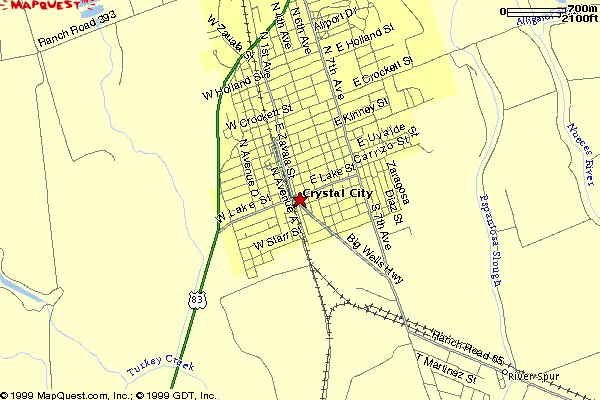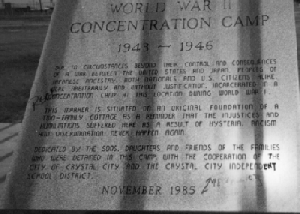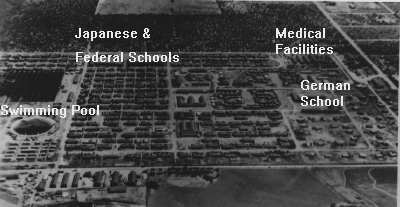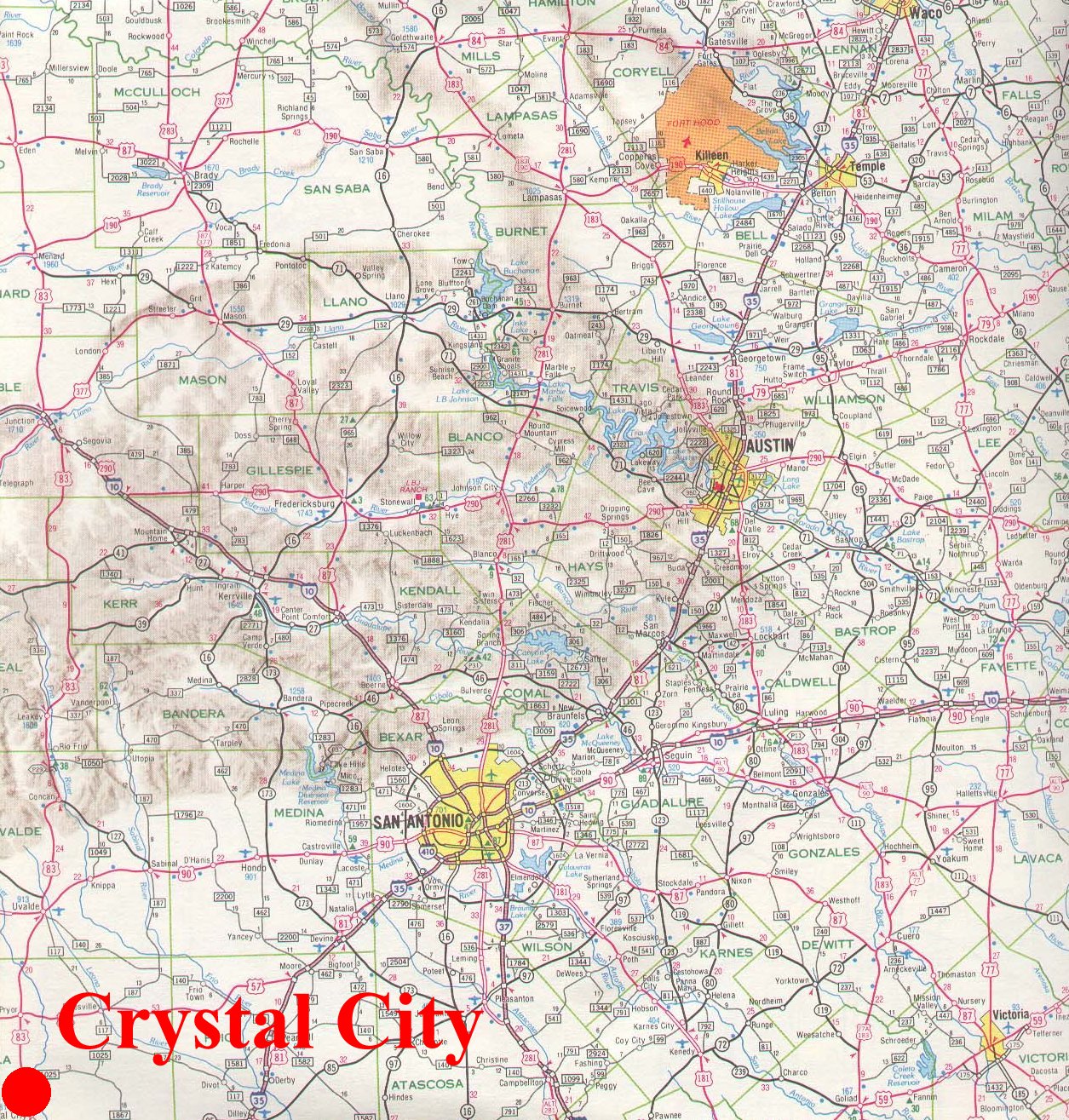 |
| Map of Crystal City *note* the railroad tracks on the map have since been removed from the city itself, and more track may be removed in the future. |
| Megan Estrada, Kyle Hellsten | Fall 2000 |
| History 1302 | R. Hines |
 |
| Map of Crystal City *note* the railroad tracks on the map have since been removed from the city itself, and more track may be removed in the future. |
Crystal City Texas, named for the clear artesian water of the area, was developed by Carl F. Groos and E.J. Buckingham in the early 1900's. In 1905 they purchased the 10,000-acre Cross S Ranch and sold off most of the land as farms. They then began to promote the town to people of the United States and foreign countries. Most of the people that moved to Crystal City were Mexican Americans (80 percent), and the minority of the population were Anglos, who ended up running the city government and the school administration.
 |
| An image of the first well in Crystal City to bring up the artesian water of the area. |
The economy of Crystal City relies heavily on agriculture. The town is known mainly for the spinach they produce, and is nicknamed the Spinach Capital of the World. In fact every second weekend of November a festival is held to celebrate the harvest of spinach, the first of which was held in 1936. Crystal City also grows onions(the first major crop), carrots, tomatoes, peppers, and other marketed vegetables. When the town first started the major transportation was the Uvalde Railroad, built in 1908 to boost the town population. Over the years the railroad was used heavily, but recently was replaced by trucks used to transport the crops. (The railroad was shut down 10 years ago, and was torn down two years ago) Crystal City lies along Highway 83 which is now used instead of the railroad as the major line of transportation.
  |
| (Left)A Popeye statue that is across from the city hall. It represents the strength of spinach as a major crop and source of income for Crystal City. (right) The building of the railroad in Crystal City. |
The most memorable event in the history of Crystal City was the period during World War II when many people were held in the internment camp located within the city. Crystal City was chosen to host the internment camp because the government had previously purchased land on the outskirts of the city during the Great Depression of the 1930's. The internment camp at Crystal City was the largest camp administered by INS and the Department of Justice. The first people arrived in the camp in December of 1942 and at the peak of the camp, it held 2,000 Americans of Japanese, Indonesian, German, and Italian descent. The camp was a big boost for the economy of Crystal City, as it employed many teachers, doctors, dentists, cooks, and many other jobs that the internment camp required. The camp was surrounded by a woven wire fence with a single guarded entrance, and consisted of four schools, six furnished dormitories, spacious lawns with paved sidewalks. Every floor of the dormitories held laundry and wash room facilities. Each dormitory also had a stove, dishwasher, refrigerator, four-person tables, china and cloth napkins. Token money, which could be used at the internment camp grocery store, was issued according to the size of the family. Many of the workers of the stores, either the General Store or the Japanese Union Store, were the people held in the camp and were payed .10 cents an hour. The camp of Crystal City was described as both a "college campus" and a "small bustling town." (Editors Note: More information about the Crystal City Internment Camp is available online. Special thanks go to Mr. Eberhard Fuhr.)
  |
| (Left) A monument to the internment camps in Crystal City. *note* This monument contains an error. It has only been made to include the Japanese-American people held in the camp, which leaves out all of the other groups that were also held at the internment camp. (Right) An aerial view of the internment camp. |
The town of Crystal City is about 100 years old, and most of the original buildings are no longer standing. There are some existing photographs of some of the first buildings in Crystal City. The first school, known simply as the Grammer School, was built in 1909 had one room and was funded by the Cross S Company. The first teacher of the school was Lucille Mount. As time progressed the town outgrew the one room and the school recieved two additional rooms to keep up with the demand for education. In 1911 a contracter, L.F. Hull added on eight new rooms and an auditorium. In 1925 it was renovated again and became the town's first two-story building. The founders of the town, Groos and Buckingham started the Cross S Hotel in 1909, but the hotel saw many owners over time. It was known for it's family style meals and had 21 rooms. Some of the families during the thirties, who didn't have their own homes lived at the Cross S Hotel.
   |
| (Left) The first school built in Crystal City. (Middle) The Cross S Hotel 1909. (Right) Lucille Mount, the first school teacher. |
Under the leadership of Jose Angel Gutierrez, the Raza Unida Party changed the school system, the government, and the county. The first issue that created the party arose at Crystal City High School in 1967 when a confrontation began about the ethnicity of the cheerleaders. A compromise was attempted by changing the squad to three white and three Mexican-American girls. In June, however the school invalidated the compromise. In the following November 100 Mexican-American students and their parents went to the school board with a list of grievances. In December 1969 the board denied charges of discrimination which caused 200 Mexican-American students to go on strike without their parents support. The boycott involved the elementary and middle schools. The Department of Justice sent a team to stop the crisis, probably the result of three striking students who visited the Washington headquarters. The federal officials met most of the students demands, including bilingual, bicultural education, better testing programs, and more cultural celebrations. The following January the Raza Unida Party won enough votes to win seats on both the school board and city council. After 10 years of leadership under Gutierrez, the party broke apart and reorganized its course of action, for the most part abandoning the Raza Unida Party and joining Democratic and Republican parties.
In the future Crystal City will remain an agricultural town, as it has been for the past century. It will continue its slow growth and the population will probably remain heavily Mexican-American. Many of the families in the town have been there for generations, and will probably stay there for generations to come. Although Crystal City is a small town it's history, and possibly it's future, will make an impact on the lives of many people.

Avila, Mine. Personal interview. Octover 31, 2000. Our interview with Mine Avila, whose has lived her entire life in Crystal City, was also very informative. She gave us a different prespective on the history of the town that she had witnessed. Her insights on the Crystal City revolts and the memories of the internment camp proved very useful.
Zavala County Historical Commision. Now and Then In Zavala County. Zavala County: Shelton Press 1985. This book was an excellent source for the history of Crystal City. It contained in depth reports on the town history and old photographs of the town.
World War II Civilian Internment Camp Crystal City, Texas U.S.A. http://www.foitimes.com/internment/cc_tx.htm This site had gave us the aerial view of the internment camp, and also provided a bit of information on the internment camps, but lacked an in-depth description of the camps.
Mark Odintz, "Crystal City," The New Handbook of Texas Online. http://www.tsha.utexas.edu/handbook/online/index.html This site provided summarized details of the town that we used to get aquainted with the town before our first visit. It also held a few paragraphs on the internment camps and the Crystal City Revolts.
Montejano, David. Anglos and Mexicans in the Making of Texas. Austin: University of Texas Press, 1987. Provided a brief description on the history of Crystal City, but lacked a lot of detail because it was not specialized on Crystal City.
Shockley, John Staples. Chicano Revolt in a Texas Town. Notre Dame, Indiana: University of Notre Dame Press, 1974. Provided a lot of information on the Crystal City revolts. Provided specific details of what happened during the revolt.
Daniels, Roger. Japanese Americans: from Relocations to Redress. Salt Lake City: University of Utah Press, 1986. This was a good source because it provided information on the internment camps and also gave detailed description of the jobs in the camp and what the people did on their free time.
Fenley, Florence. Oldtimers: Frontier Days in the Uvalde Section of Southwest Texas. Uvalde: Hornby, 1939. This was not the best source to use because it focused more on Zavala County then on Crystal City, but it did have some great information on the spinach and other crops that are grown in Crystal City.
Map Quest. http://www.mapquest.com This was a good spot to find a map for any location. It gave us a great map of Crystal City.